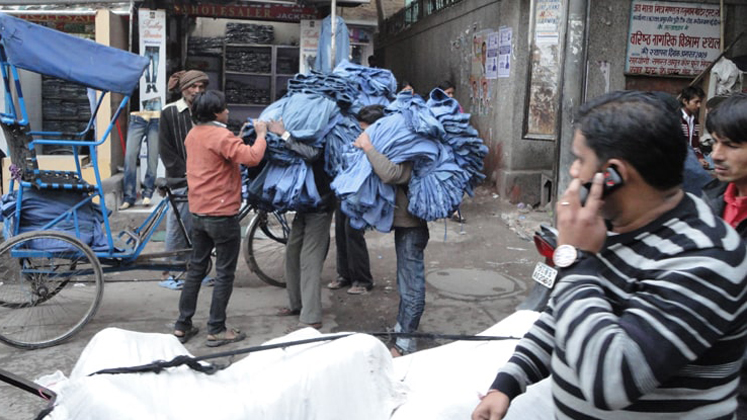Denim jeans exports from India is negligible, despite that India produces around 1.80 billion metres of denim fabrics a year – second only to China! However, with a population of over 1.35 billion, the domestic market for 5-pocket jeans is ever-flourishing. Surprisingly, most of this requirement is fulfilled by thousands of small denim factories located in unorganised clusters/hubs across India such as Tank Road, Seelampur, Gandhi Nagar, Tughlakabad Extension (Delhi), Ballari (Karnataka), Ulhasnagar (Maharashtra), and Gheekanta and nearby areas (Ahmedabad).
Despite all the seismic shifts that the apparel industry has witnessed recently after pandemic, these hubs claim to be evolving and improving. If market sources are anything to go by, these hubs are making around 75 to 80 per cent jeans for the Indian domestic market and are exporting a small chunk of their production to Gulf countries as well.
Bangladesh vying for the Indian denim market
Domestic apparel manufacturing in the organised sector is estimated at US $ 30 billion in India. In an apparel retail industry that’s worth US $ 88 billion and is predicted to reach US $ 110 billion by 2027, these numbers are astonishing! Even if every person in India wears jeans, there would be still a requirement of around 1.35 billion jeans. As per statistics, Indian denim jeans industry is worth Rs. 50,000 crore (US $ 6.80 billion) in 2022, while the quantity-wise consumption is around 680 million pieces. That’s just 50 per cent of the total requirement!
Indian apparel market is a rich mix of wholesalers, importers, brands, e-commerce companies and retailers. Big retailers like Reliance Retail, Aditya Birla and Arvind have been sourcing from Bangladesh for quite some time now. Reliance Retail alone sourced nearly 6.50 million apparel products from Bangladesh in 2019 which, reportedly, increased to over 10 million pieces in 2021 and, seeing the massive rise of Reliance Retail after its recent expansion spree, it is safe to say that this number is continuing to grow. Around 40 per cent of these sourced products are denim apparel!
Bangladesh has sensed the worth of Indian apparel retail market well in recent times as the country is eyeing the Indian domestic retail industry. Currently, Bangladesh is shipping around US $ 550 million worth of garments to India in a year, which is poised to grow to US $ 1 billion in next 4 years. Denim is playing a huge role in this.
Not just big retailers, but wholesalers have also turned to Bangladesh now for their sourcing needs, especially in the denim category. A 5-pocket jeans that is being produced by a typical factory in Indian’s domestic hubs costs around Rs. 280-300, while the same in case of Bangladesh is nearly US $ 4.20 (Rs. 320), excluding transportation costs.
In fact, the cost of manufacturing in Bangladesh is much lower than other South Asian countries; while they get advantage of low-cost fabric imports too. Indian denim mills ship around 39 per cent of total denim produced in the country to Bangladesh, the cost of which is similar to the cost of fabric these mills ship in the domestic market. This no-price difference is due to duty-drawback advantage that Indian mills are getting in Bangladesh market.
Another advantage that wholesale importers are getting from Bangladesh is high-quality of the sourced goods. They know Bangladesh’s factories have required skill set for producing goods for the export markets, so they work on quality, value-addition as well as produce basic denim jeans too, as per buyers’ requirements. The importers also get significantly higher efficiencies in Bangladesh’s factories where large volume orders are also taken care of as factories are scalable in denim garmenting with good knowledge in dry and wet processes.
Individual hub’s strengths are making Indian denim making industry wholesome
Highly dense and narrow streets, movement of indigo fabric and cut panels across streets and second-hand machines that start early in the morning and churn out jeans till late night is a typical scenario in most of these hubs. Work is fragmented as various operations take place mostly in separate streets – sewing, cutting, dyeing, button hole etc.– and final jeans come at single point for packaging only. Fabric and other raw materials are sourced from nearby wholesalers and mills’ agents. Working through wholesalers and dealers is a standard in these hubs.
These are some common threads in these hubs but every hub is also known for its individual strengths. Like Gandhi Nagar, nearby areas of Tank Road and Karol Bagh etc., are known for funky designs. Creativity and excellence in fashion are some of the biggest advantages of the hub and it also has the support of washing in areas like Loni (Ghaziabad) and Badi (Sonipat).
The majority of denim that this cluster produces are of polyester base. The thing in favour of Gandhi Nagar and other allied areas of Delhi is that many jeans firms are not only producing jeans, but they are also into trousers and shirts.
It gives them the added advantage of a large client base. Gandhi Nagar is now also getting stitching job work done from Sambhal (Uttar Pradesh) which has ample jeans expert workers.
Ballari offers bottoms for men and kids while few are also producing denim for girls and women. The hub has the advantage of local workforce and only a few migratory workers are there in washing units only. But it is lacking behind on the quality front especially as far as the wash is concerned. The hub survives as it offers products on credit and caters to the main states of South India like Karnataka, Andhra Pradesh, Tamil Nadu, Kerala and Telangana mainly.
Ulhasnagar near Mumbai supplies jeans across the country but its core markets are Maharashtra, Gujarat, Chhattisgarh, MP and some cities of Tamil Nadu. Using mainly cotton base and producing sober designs makes Ulhasnagar carve a unique niche for itself. Lycra, linen and other variety of fabrics are also being used here. The city has a culture of manufacturing as it is also into the production of footwear, plastic-based packaging material and some other things.
Ahmedabad is the only hub of India which has giants like Ashima, Aarvee Denim, Arvind Ltd., Vishal Denim and many more as well as thousands of SME jeans manufacturers. Local fabric sourcing is the biggest advantage of the hub. Not only big mills but also medium-level denim fabric producers can be found in this hub and their rates are also less compared to big mills. Even some such SME denim fabric producers have width of 70 inches in their fabric which is around 5 inches higher than mill fabrics.
The city supplies jeans mainly to Gujarat, Uttar Pradesh, Madhya Pradesh, South India and few other states of India. Ahmedabad is known for its quality and fitting as the hub hardly has size issue. Interestingly, these small hubs across India house denim units with just 10 or more machines and sell denim jeans to big domestic retailers, shops, wholesalers as well as brands. What works in favour of these small denim units is the low cost of products which is something domestic buyers search for.
“Understanding the local requirement and culture, products are being made by us in bulk which is not possible if buyers turn to other countries!” commented a factory’s owner in Delhi.
K K Balli, President of the Association of Wholesale Readymade Garment Dealers (Gandhi Nagar) adds another advantage for factories working locally, “Even if a retailer doesn’t pick his confirmed orders, we have options to sell it in the open market and that too without any big impact. This strength is not there with the big manufacturers of organised hubs in India.”
Old Challenges, however, still continue!
Over the years, overall working of all these hubs has improved as some of the manufacturers have set up reasonably big units and strengthened their brands or are working with retail giants. Still, all these hubs have majority of unorganised units and some of them are even working illegally, without following law of the land. Though it helps them to be cost-effective but they can’t survive in long run as action against such units is a routine affair for Government officials also. This builds a negative impact on the image of the hub.
At the same time, the lack of very basic amenities be it proper parking, inadequate hygiene facilities like public toilets etc., in these areas are also hindrances towards their growth as many retailers, wholesalers pay less visit to these hubs.

Gandhi Nagar, Delhi)
Fresh challenges pose greater threat in future
Post-Covid, nearly all the segments of textile industry have revived and reached up to pre-Covid level, still many firms from these hubs have not recovered or are still struggling to touch pre-Covid level.
Now there is a major change – most of the manufacturers don’t keep stock with them as they used to do prior to Covid. Credit system was the backbone for these unorganised hubs and now with the volatility in the fabric price and no credit on fabric by mills and their further distribution channel has forced many manufacturers to consolidate their operations.
In these hubs, there are mostly two types of manufacturers: firstly those who are aggressively focusing on new designs, different kinds of finishes, lot of value addition and also exploring newer fabric available with the mills; and the second type of manufacturers are lacking on this front and are just continuously making their regular products, without any thrust on product development or newness in their offerings.
Tapasvilal C Jain, President, District Jeans Garments Merchants Association, Ballari states, “No doubt, there is good demand across India for all kinds of denim products but Ballari’s jeans manufacturing is still facing plenty of challenges. Apart from the market conditions especially credit issue, our hub is lacking on innovations in products and a major reason for the same is that manufacturers don’t wish to increase their cost. But sooner or later they have to be innovative.”
Despite all the odds, manufacturers from these hubs are sure for growth in future as they believe that it is a phase of filtration. The players which have thrust on innovation, deep pockets and provide best services to their clients, will witness huge business as demand is rising.
“Our industry survives season-to-season but even this festival season is not as per our expectation, however we are optimistic about the marriage season. Even if one season goes well, we will get support to work for next few seasons, so we are positive that the market will keep supporting the good demand,” says K K Balli. He further adds that as the price of cotton with new crop is also getting stable, it will also be a big support for denim manufacturers.
As garment manufacturing is increasing in every state, players in these old established hubs are increasing their focus on quality, price and service so that they can compete with newly emerging units which have benefits of local production and local supply.
If these hubs improve their overall working and Government, local administration also support them, there is nothing which can stop them from growing multifold.
| HUB | Scale of operations |
| Ahmedabad | 800+ reasonably sized firms for denim products mainly |
| Ballari | 500+ jeans manufacturing units having satisfactory infrastructure
|
| Gandhi Nagar/Seelampur/Tughlakabad Extension/Tank Road | 6,000+ manufacturing units |
| Ulhasnagar | Around 1 lakh people are employed in jeans manufacturing activities |







